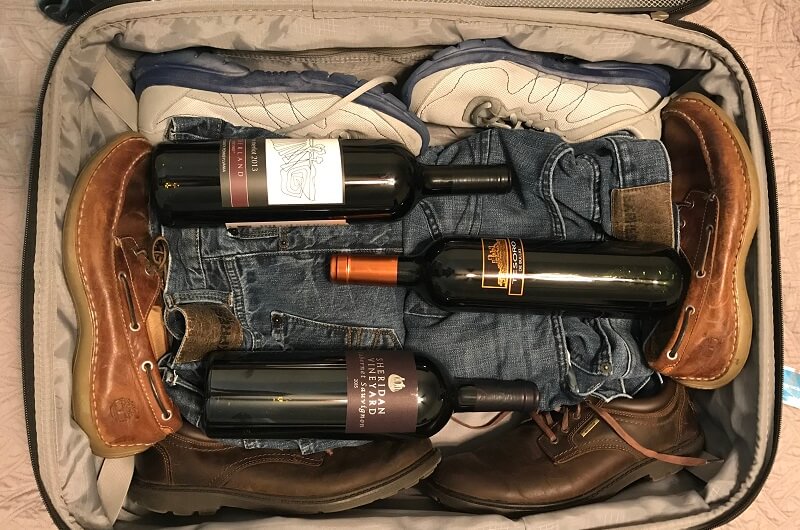Ah, wine—nectar of the gods, a sip of luxury, or perhaps just your go-to unwind strategy after a long day. There’s no denying the pleasure of discovering a fabulous wine while traveling, be it a rustic Château from Bordeaux, a crisp Riesling from Germany, or a fruit-forward Shiraz from Australia. But once you’ve found that liquid gold, the question arises: “Can I safely transport this wine in my checked luggage without any catastrophic mishaps like explosions?”
In this guide, we will dissect this question from every angle to ensure that your prized bottles reach home safe and sound. We’ll delve into the science, the logistics, and the regulations that can influence the integrity of your wine when you’re flying high.
The Science Behind the Concern
Pressure and Altitude
The first thing you might wonder about is the effect of pressure and altitude on wine bottles. Commercial airplanes typically cruise at altitudes between 30,000 and 40,000 feet, where the atmospheric pressure is much lower than at sea level. Does this pose a risk to your wine? Generally, the answer is no. Wine bottles are designed to be pretty robust, and the cargo holds in planes are pressurized and climate-controlled to some extent, which minimizes the risk of an explosion due to changes in pressure or temperature.
Bottle Integrity
Wine bottles, particularly those made from glass, are crafted to withstand a good deal of pressure from the inside. This is especially true for sparkling wines like Champagne, which have significantly higher internal pressures. Unless the bottle has some kind of flaw or damage, the likelihood of it bursting under normal conditions is low.
Temperature Fluctuations
While pressure might not be a huge concern, temperature is another matter. Wine is sensitive to temperature changes, and extreme temperature fluctuations can affect its quality. However, unless exposed to extreme cold that would cause the wine to freeze (and thus expand), temperature changes in the cargo hold are unlikely to cause the wine bottle to explode.
Precautions and Packing Tips
The Right Packaging Material
One of the first lines of defense against potential breakage or leakage is choosing the right packaging material. Options range from specialized wine shippers made of Styrofoam to inflatable wine bags. The key is to immobilize the bottle to prevent movement that could result in breakage.
- Styrofoam Wine Shippers: These are molded to fit wine bottles and offer excellent protection.
- Inflatable Wine Bags: These bags inflate around the bottle, providing cushioning and immobilizing the bottle within your luggage.
Layering
Even with a good packaging choice, it’s advisable to add additional layers of protection. Wrapping the bottle in clothes or using bubble wrap can add an extra layer to safeguard against any unforeseen rough handling during transport.
Positioning
How you position the wine bottle in your luggage also matters. It’s generally advised to place it in the center of your luggage, cushioned by clothes or other soft items. This minimizes the chance of impact from any angle.
Sealing and Securing
You might also consider sealing the cork with wax or tape to prevent any minor leaks. This isn’t generally necessary, but if you’re carrying a particularly valuable bottle, it’s a step worth considering. Zip-loc bags can also provide an additional layer of protection against leaks.
Regulations and Restrictions
Alcohol Content Limits
Different countries have varying regulations regarding the importation of alcohol. It’s essential to check the specific alcohol content limits for the destination you’re traveling to. If your wine exceeds these limits, you might encounter issues with customs.
Duty and Taxes
In some cases, you may be required to pay duties and taxes on the wine you’re bringing into a country. These charges can vary significantly depending on the country and the quantity of wine you have. Be prepared to declare your wine and pay any applicable fees at customs.
Quantity Limits
Most countries impose limits on the quantity of alcohol you can bring with you. These limits are usually defined by the number of bottles or liters. Exceeding these limits can lead to confiscation or fines.
Packaging Regulations
Some countries have specific packaging regulations for alcohol, including wine. For example, certain countries may require that wine be packed in original, unopened packaging to be allowed through customs.
Airline Policies
It’s not just customs and destination regulations you need to consider; airlines also have their policies regarding transporting alcohol. Check with your airline to understand their rules and restrictions on carrying wine in your checked luggage.
Conclusion
So, will wine explode in checked luggage? The short answer is that it’s highly unlikely. Wine bottles are built to withstand changes in pressure and temperature, and the cargo holds of commercial airplanes are pressurized and climate-controlled to a certain extent.
However, while explosions are improbable, there are still factors to consider. Protecting your wine with proper packaging, insulation, and cushioning is essential to prevent breakage. Additionally, understanding and adhering to the regulations of both your departure and destination countries, as well as airline policies, is crucial to ensure a smooth and legal transport process.
By following the tips and precautions outlined in this guide, you can transport your precious bottles of wine with confidence, knowing that they are well-prepared for the journey and that you are in compliance with all relevant regulations.
Bon voyage and cheers to enjoying your wines from around the world!
